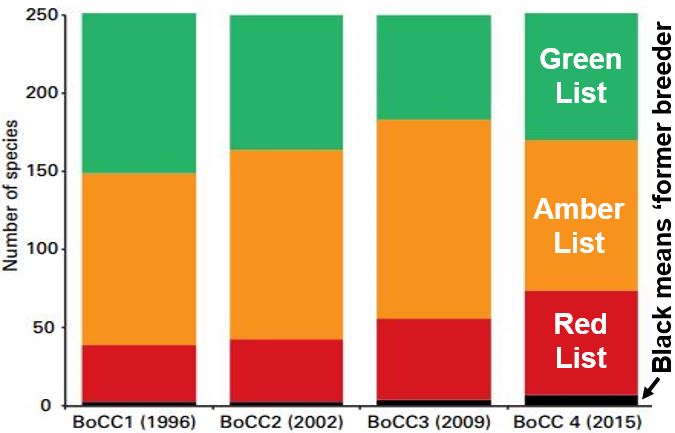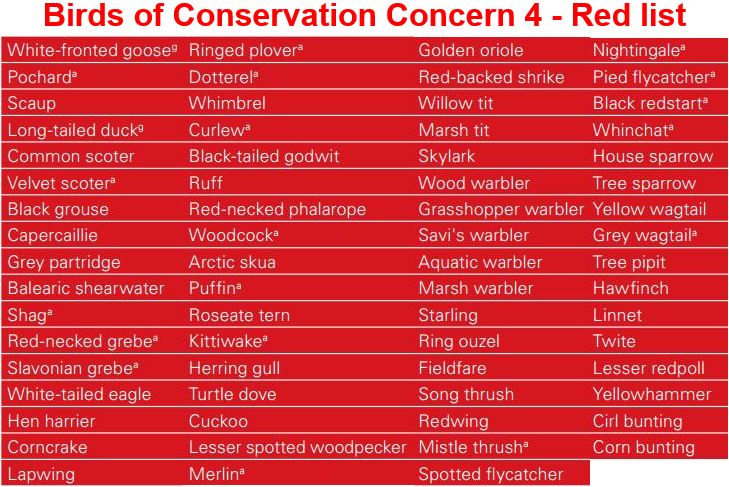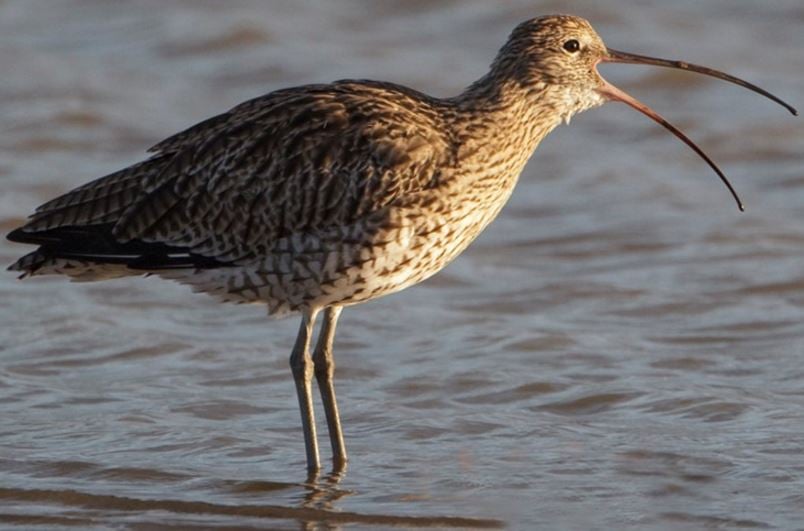Over one quarter of the 244 species of British birds are today under threat of extinction and are now of ‘highest conservation concern’, says Birds of Conservation Concern 4, a new report. Sixty-seven British bird species have now been placed on the assessment’s Red List, with some new additions, including curlews, nightingales and puffins, which join other familiar species such as starlings, cuckoos and turtle doves.
Twenty-seven percent of all the bird species in the United Kingdom are currently on the Red List. In the previous assessment, which occurred in 2009, fifty-two species (21%) were on the Red List.
Of the sixty-seven species that are now of highest conservation concern, several have experienced severe population declines, having halved in numbers or range in Britain in recent decades, while others remain far below historical levels, or are facing a serious global extinction threat.
 Since 1996, the Red List has grown while the Green List has shrunk. (Source: Birds of Conservation Concern 4)
Since 1996, the Red List has grown while the Green List has shrunk. (Source: Birds of Conservation Concern 4)
Many much-loved species in trouble
Martin Harper, RSPB (Royal Society for the Protection of Birds) Conservation Director, said:
“This update highlights the continued erosion of the UK’s wildlife. It is sobering that much loved species such as curlew, puffin and nightingale are now of highest conservation concern in the UK. They are sounding the alarm that things are going wrong in our uplands, our seas, and for our migratory species. Addressing these declines must now become a priority.”
“But, we must remain optimistic. This latest assessment shows that when have diagnosed the problem, identified solutions, and when conservation action is targeted and adequately funded, we can bring species back from the brink.”
The report was compiled by a coalition of Britain’s leading bird conservation and monitoring organisations, which review all regularly-occurring species in the Isla of Man, the Channel Islands and UK.
Each individual species is assessed against a set of objective criteria. The authors then decide whether to place them on the Red, Amber or Green List, with the red indicating the highest level of conservation concern (and green the lowest).
 Some very familiar and much-loved birds are now in the UK’s Red List – a = species on the Amber list previously, g = species on the Green list previously. (Source: Birds of Conservation Concern 4)
Some very familiar and much-loved birds are now in the UK’s Red List – a = species on the Amber list previously, g = species on the Green list previously. (Source: Birds of Conservation Concern 4)
More upland species in trouble
Five upland species have been added to the Red List, most notably the curlew – the largest wading bird in Europe and easily recognisable by its long legs, evocative call, brown upper parts, and long down-curved bill.
The curlew was recently highlighted as maybe Britain’s bird of highest concern priority because of declines in the UK and abroad, and the global importance of its population in the UK.
The grey wagtail, whinchat, dotterel and merlin were also added to the Red List, highlighting the fact that several of Britain’s upland species are in increasing trouble. There are now twelve upland birds in the Red List.
More woodland birds and seabirds added to the list
Since the last list was compiled six years ago, the decline of widespread woodland birds has become a developing theme. The nightingale, loved for its expressive song, the pied flycatcher, a bird that occurs mainly in the west of the UK, and woodcock are the most recent woodland species to be included in the Red List.
Three seabird species have joined the Red List for the first time. The puffin, with its distinctive coloured bill, is experiencing severe population declines globally, and is now at risk of global extinction.
Kittiwake and shag populations have also diminished considerably.
 The curlew has been highlighted as possibly Britain’s bird of highest conservation priority. (Image: RSPB)
The curlew has been highlighted as possibly Britain’s bird of highest conservation priority. (Image: RSPB)
The wryneck, which was once a widespread species, is no longer a breeding bird in the UK – the first time this has happened in any British species in 200 years.
Between 1875 and 1900 it used to be a very common bird and was recorded breeding in 54 different nations. After a long decline over the past 100 years, it was last known to breed in Britain in 2002, and is today considered a former breeder. The wryneck still visits Britain in the autumn (as a migrant), usually along the eastern and southern coasts.
Targeted efforts paying off
Within all this gloom, fortunately there is some good news in the report, which demonstrates that well-targeted conservation action can make a huge difference. The dunlin, nightjar and bittern are no longer in the Red List – they have been moved to Amber.
The bittern – a type of heron famous for its booming call – is bouncing back to full recovery after virtually becoming extinct in Britain at the turn of the 20th century. In 1997, just 11 booming males were recorded in England, and the species was heading towards a second extinction.
Thanks to efforts to improve its favourite habitat – wet reedbed – and considerable funding under the European Union Life Program for two projects, the bittern has been saved. In 2015 a total of 150 booming males have been counted in England and Wales, more than at any time since the first half of the 19th century.
Likewise, the nightjar – a hawk-like bird of the moorlands, heathland and woodland that hunts at night – has also thrived thanks to a program of concentrated and targeted conservation work.
David Stroud, Senior Ornithologist at JNCC (Joint Nature Conservation Committee), said:
“The improved status of Bittern and Nightjar following two decades of targeted conservation delivery shows that with adequately resourced implementation, we can restore even highly threatened species – as these were in the 1990s. We need urgently to similarly address the factors causing the poor status of very many other species on the Red list.”
Twenty-two other species have been promoted from Amber to the Green List, i.e. today they are of the lowest conservation concern. Among them is the woodlark and red kite. Red kites used to occur just in Wales, but thanks to the efforts of landowners and conservationists in Wales and a long-term reintroduction programme in the rest of the UK, they can now be found all over Britain.
Improved land management, especially of heathland, has benefited the woodlark significantly.
Richard Hearn, Head of Monitoring at WWT (Wildfowl & Wetlands Trust), said:
“There’s good news and bad in this report. Though it’s easy to get disheartened by the worsening status of our bird populations, the key message is that if we have the knowledge and the support, we can turn fortunes around. Birds of Conservation Concern brings together all the latest knowledge and helps us build the case for supporting conservation of the species most in need.”
David Noble, Principal Ecologist – Monitoring at BTO (British Trust for Ornithology), said:
“The new list demonstrates the crucial importance of long-term monitoring and the huge volunteer effort associated with them. Six species (Nightingale, Curlew, Whinchat, Pied Flycatcher, Grey Wagtail and Mistle Thrush) have moved from amber to red entirely due to evidence from the Breeding Bird Survey of continued and more severe declines in their breeding populations. Three species (White-fronted Goose, Ringed Plover and Red-necked Grebe) moved to red due to increasingly severe declines in wintering populations revealed by the Wetland Bird Survey.”
